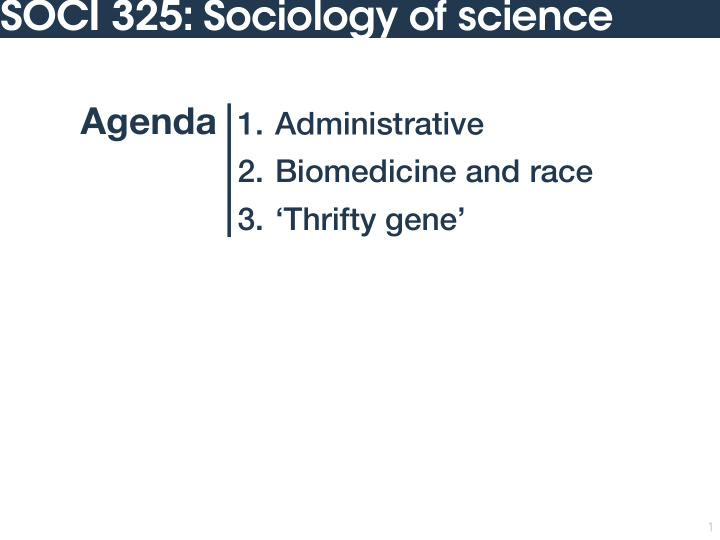



SOCI 325: Sociology of science Agenda 1. Administrative 2. Biomedicine and race 3. ‘Thrifty gene’ 1
Administrative Lecture participation (Zoom) ⦙ Please keep your video and mic turned o ff . ⦙ Tay and I will be keeping an eye on the text chat window . ⦙ If you have a question, either ask directly in chat or “ raise your hand ” (I will call on you to turn on your mic). ⦙ Keep in mind, the video and text chat are all being recorded , and the video will be shared with the class. Lecture recordings ⦙ Shortly after class, lecture recordings (with transcripts) will be posted online and linked from the syllabus. ⦙ Hosted on Microsoft Stream — you should all have access to the group and all the lecture videos (email me if not!) ⦙ If you have limited bandwidth , I can send you the transcript to use with the slides. 2
Administrative Discussions ⦙ Discussions will no longer be in class (synchronous). ⦙ Each group will need to schedule and organize their own discussion format. ⦙ Some resources for this listed at https://soci325.netlify.com/tools.html ⦙ You have until the following day at midnight to submit your responses. e.g. today’s discussion responses due Wednesday night at 11:59pm (23h59) O ffi ce hours ⦙ Zoom meeting (linked on syllabus) ⦙ Simultaneous text chat on MyCourses 3
Biomedicine and race 4
Biomedicine and race Western European men ⦙ Historically, biomedical research has focused on white men. ⦙ The types of questions asked and the kinds of treatments developed show consistent bias. ⦙ The doing of biomedicine has long been dominated by white men Promotional image for a device to convert the ubiquitous “male” Skewed knowledge CPR mannequins to “womanikins” with breasts. source: NPR ⦙ Many argue that this leads to more and better knowledge about some problems. ⦙ E.g. heart disease and men 5
Biomedicine and race “Inclusion-and-di ff erence” paradigm Changes in legislation and norms of research since the late 1980s have altered the role of race and gender for biomedicine. “Inclusion-and-di ff erence” (Steven Epstein) ⦙ Inclusion : Research should explicitly seek to include members of under- represented groups (e.g. women, racialized categories). ⦙ Di ff erence : Research should seek out differences between those groups (e.g. incidence rate, mortality rate, treatment e ff ectiveness, …). The paradigm was championed by practitioners and activist groups seeking to make biomedical research more inclusive. Currently enforce by law or by the policies of funding agencies 6
Biomedicine and race Consequences of “Inclusion-and-di ff erence” Categories of inclusion (gender, race, socioeconomic status, …) have become an a priori assumption of research design . “Successful” research depends on finding inherent differences between, e.g., indigenous and settler populations. Within existing power structures (neo-colonialism, capitalism, ableism, patriarchy) the reification of these di ff erences reinforces oppressive institutions . A focus on categorical, presumed-biological di ff erences can mask underlying social issues (poverty, access to healthcare) that cause health di ff erences. 7
The ‘thrifty gene’ 8
The ‘thrifty gene’ Thrifty gene hypothesis ⦙ Aims to explain prevalence of some forms of diabetes among certain Aboriginal peoples ⦙ Proposes that European colonial expansion caused changes to Aboriginal diets ⦙ Presumes that Aboriginal peoples are genetically adapted to “feast-and-famine” ⦙ Switch to “feast-only” diets predisposes Aboriginal peoples to diabetes and obesity Photo by Jay Wennington 9
The ‘thrifty gene’ Jennifer Poudrier (2007) Existing research on ‘thrifty gene’ hypothesis relies on and reinforces “problematic and intersecting binaries” such as “civilized/primitive, Aboriginal/non-Aboriginal and science/culture.” (p. 239) Poudrier seeks to “de-naturalize” and decolonize the theory. This means, among other things, that any discussion of the intersection of race, health, and genetics for Aboriginal peoples must include voices and perspectives of those people at a basic level. She uses this perspective to confront two implicit assumptions of a ‘thrifty gene’ analysis of the Aboriginal population of the Oji-Cree of Sandy Lake, Ontario: genetic homogeneity and the validity of the the comparative groups . 10
The ‘thrifty gene’ Decolonizing methodologies (Linda Tuhiwai Smith, 1999) ⦙ Western scientific research is “inextricably linked to European imperialism and colonialism.” (p. 30) ⦙ Scientific research on and about colonized peoples is inherently exploitative. ⦙ Current issues of health, inequality, poverty, etc. are part of the broad historical narrative. ⦙ Indigenous peoples have “counter stories” that challenge categories and paradigms of Western science. ⦙ Does not seek to fully reject Western science, but to turn it into one part of a larger discourse. 11
Recommend
More recommend